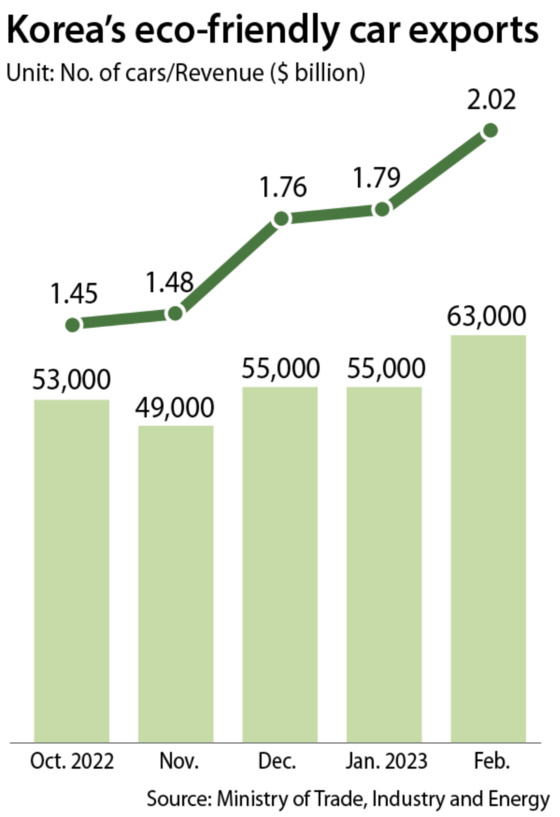Korea's auto and auto part exports beat chip exports
![Hyundai Motor vehicles for export wait at a dock in Ulsan on Monday. [NEWS1]](https://koreajoongangdaily.joins.com/data/photo/2023/03/20/abb92c7c-bacf-4397-a6f9-b4c7dc364ec7.jpg)
Hyundai Motor vehicles for export wait at a dock in Ulsan on Monday. [NEWS1]
The car and auto component export category is now Korea’s biggest, beating chips.
The combined revenue of cars and auto component exports was $7.6 billion in February, 15.2 percent of the country’s total exports, according to data from the Ministry of Trade, Industry and Energy on Monday.
That was more than February’s semiconductor exports, which came in at $5.96 billion. It’s the first time in six years that auto exports beat chip exports.
Vehicle export revenue alone reached an all-time high of $5.6 billion in February, up 47.1 percent on year, on strong demand for eco-friendly vehicles.
In terms of volume, exports surged 34.8 percent on year to 222,934, the data showed.

Exports of auto components rose 13.3 percent to $2 billion during the same period. Sales to North America were particularly good, with the revenue rising 21 percent to $721 million.
“Increased demand for eco-friendly vehicles highly impacted the strong performance,” the Trade Ministry said in Monday’s statement.
Exports of eco-friendly cars soared 83.4 percent to an all-time high of $2.02 billion in February. Eco-friendly vehicles include pure electric vehicles, hybrids and hydrogen-powered vehicles.
In terms of volume, Korea sold 62,861 cars overseas last month, a 61.1 percent year-on-year increase. It’s the first time monthly exports broke the 60,000 mark since the ministry started collecting related data.
Exports of EVs jumped 76.6 percent to 30,843 in February, while exports of hybrids rose 48.8 percent on year.
A total of 40 hydrogen-powered cars were exported, a 1,900 percent increase.
By region, car exports to North America surged 65.7 percent to $2.74 billion, while those to the European Union rose 35.3 percent to $855 million.
Shipments to Middle Eastern countries jumped 47.8 percent to $502 million, while those to Asia soared 81.2 percent to $455 million.
![President Yoon Suk Yeol, left, talks with Hyundai Motor Group Executive Chair Euisun Chung during his visit to Hyundai Motor's manufacturing plant in Ulsan on March 9. [JOINT PRESS CORPS]](https://koreajoongangdaily.joins.com/data/photo/2023/03/20/f1da7ffd-2e71-469e-91cd-59d49542219a.jpg)
President Yoon Suk Yeol, left, talks with Hyundai Motor Group Executive Chair Euisun Chung during his visit to Hyundai Motor's manufacturing plant in Ulsan on March 9. [JOINT PRESS CORPS]
GM Korea exports rose 22.6 percent and SsangYong Motor 43.9 percent.
Exports for Renault Korea Motors declined 36.7 percent as sales of its XM3 declined.
Car exports are still growing in March.
Auto export revenue came in at $1.7 billion for the first 10 days of March, a 133.7 percent increase compared to the same period the previous year, according to the latest data from the Korea Customs Service.
Hyundai Motor and Kia became the third largest automaker in the world as of last year, beating General Motors and Stellantis.
The two Korean automakers sold a total of 6.85 million vehicles globally last year, up 2.7 percent on year, right after Toyota and Volkswagen.
It's the first time the combined sales of Hyundai Motor and Kia reached the top 3 in the global market in 47 years since Hyundai Motor produced its first vehicle, the Pony.
BY SARAH CHEA [chea.sarah@joongang.co.kr]










with the Korea JoongAng Daily
To write comments, please log in to one of the accounts.
Standards Board Policy (0/250자)